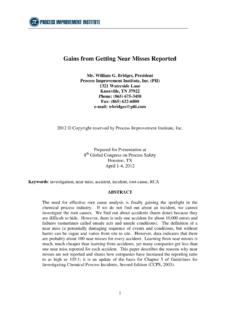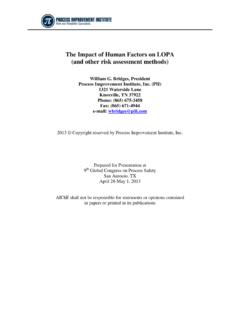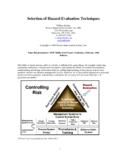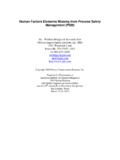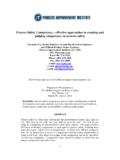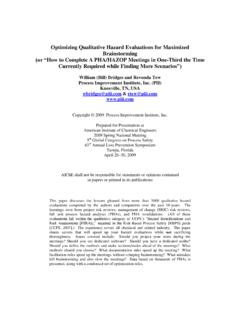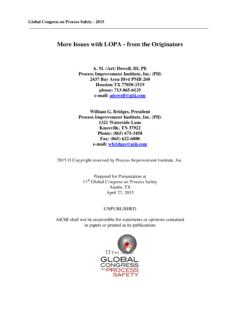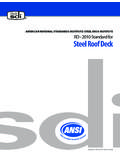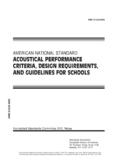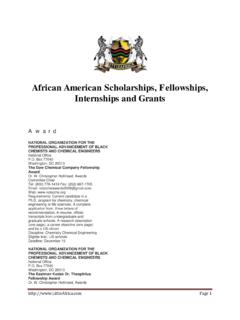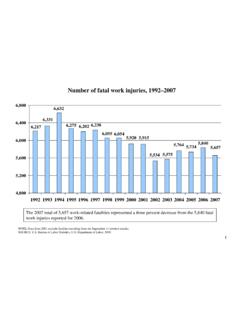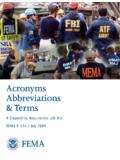Transcription of Issues with Use of LOPA - Perspective from an Originator ...
1 5th Global Congress on Process Safety 11th Plant Process Safety Symposium Key Issues with Implementing LOPA (Layer of Protection Analysis) . Perspective from One of the Originators of LOPA. Copyright 2009. American institute of Chemical Engineers 3 Park Avenue New York, New York 10016-5991. All rights reserved. No part of this publication may be reproduced, stored in a retrieval system, or transmitted in any form or by any means, electronic, mechanical, photocopying, recording, or otherwise without the prior permission of the copyright owner. AIChE and CCPS are trademarks owned by the American institute of Chemical Engineers. These trademarks may not be used without the prior express written consent of the American institute of Chemical Engineers.
2 The use of this product in whole or in part for commercial use is prohibited without prior express written consent of the American institute of Chemical Engineers. To obtain appropriate license and permission for such use contact Scott Berger, 212- 591-7237, It is sincerely hoped that the information presented in this volume will lead to an even more impressive safety record for the entire industry; however, the American institute of Chemical Engineers, its consultants, CCPS Subcommittee members, their employers, and their employers officers and directors disclaim making or giving any warranties or representations, express or implied, including with respect to fitness, intended purpose, use or merchantability and/or correctness or accuracy of the content of the information presented in this document.
3 As between (1) American institute of Chemical Engineers, its consultants, CCPS Subcommittee members, their employers, their employers officers and directors and (2) the user of this document, the user accepts any legal liability or responsibility whatsoever for the consequences of its use or misuse. AIChE Copyright 1967-2009. Key Issues with Implementing LOPA (Layer of Protection Analysis) . Perspective from One of the Originators of LOPA. William (Bill) Bridges and Tony Clark Process Improvement institute , Inc. (PII). Knoxville, TN, USA. ABSTRACT. This paper focuses on problems observed with LOPA during the first 8-years of broad use. One the biggest Issues is that organizations use LOPA without following the rules for LOPA, especially the rules related to maintaining, testing, and record-keeping for each independent protection layer (IPL) and for each optimized initiating event (IE).
4 Some companies use the values for an IPL or IE listed in the LOPA guideline book (CCPS, 2001), or elsewhere, but without implementing the management systems to maintain the IPL or IE at the claimed PFD value. Another issue is that many companies and analysts overuse LOPA. For instance, IEC. 61511 allows a qualitative PHA team to determine if a SIF is needed for a scenario and to specify a SIL 1 or 2, if one is needed. Yet, most folks believe that only LOPA, RiskGraph, or QRA is valid for determining if a SIF is needed and then use the same method to determine what SIL is needed. The LOPA book authors expected the number of scenarios going to LOPA (after a HAZOP/PHA) would be 1% to 10% (max) of those uncovered in a qualitative analysis (maybe after 100 HAZOP nodes, you would do 1-10.)
5 LOPA). Some of us believed that a PHA team would recommend (or use) LOPA only if the scenario was too complex for the PHA/HAZOP team. It appears that most companies are using LOPA for every scenario that has a severe consequence; this results in doing LOPA on much greater than 10% of the scenarios. Many times there is weak definition of the consequence that is being avoided, so an IPL. does not always match up well with the consequence. LOPA is also overworked when it is used. Many of us on the original LOPA book authorship considered LOPA a single analyst job, after a PHA/HAZOP. Instead, the trend appears to be that companies (or perhaps their consultants) make LOPA part of the PHA (in-situ), therefore involving the whole PHA team. LOPA is used in PHA team settings, which distracts PHA teams from their primary task of brainstorming to identify the accident scenarios that can occur.
6 This paper also summarizes the many benefits LOPA has produced for the industry. Brief History of LOPA. The initial development of layer of protection analysis (LOPA) was done internally within individual companies. However, once a method had been developed and refined, several companies published papers describing the driving forces behind their efforts to develop the method, their experience with LOPA, and examples of its use (Bridges, 1997; Dowell, 1997; Ewbank and York, 1997). In particular, the papers and discussion among the attendees at the October 1997 CCPS (Center for Chemical Process Safety, part of AIChE), International Conference and Workshop on Risk Analysis in Process Safety, brought agreement that a book describing the LOPA method should be developed.
7 In parallel with these efforts, discussions took place on the requirements for the design of safety instrumented systems (SIS) to provide the required levels of availability. United States and international standards (ISA [1996], IEC [1998 and 2000]) described the architecture and design features of SISs. Informative sections suggested methods to determine the required safety integrity level (SIL), but LOPA was not mentioned until the draft of International Electrotechnical Commission (IEC) 61511, Part 3, which appeared in late 1999. These Issues were summarized in the CCPS workshop on the application of ISA S84, held in 2000. The first LOPA book was developed by a CCPS committee from 1997 through 2000 and was published in 2001 (William Bridges was one of the principal authors of that guideline).
8 LOPA became widely used following the publication and most companies around the world have used LOPA, with some companies having used LOPA a lot. During roughly 10-years of widespread use of LOPA, and especially during the last 5-years, use of LOPA has greatly accelerated. It is likely that 1 million LOPAs have been performed. During this same period, many abuses of LOPA have been noted and several innovations have occurred. In 2007, CCPS commissioned a new guideline book (1) to expand the list of independent protection layers (IPLs) and initiating events (IEs) and (2) to try to remedy some of the major Issues noted in the use of LOPA. The new (future) book is discussed in another paper at this conference; this book is due into publication in early 2010.
9 Intent of LOPA. LOPA is one of many methods for assessing a given scenario to determine if the risk is acceptable. It uses rigid rules to simplify and standardize the definitions of independent protection layers (IPLs) and initiating events (IEs). If these rules are followed, then the simplified risk assessment math of LOPA is valid and the risk assessment should give an order-of-magnitude approximation of the risk of a given cause-consequence pair (scenario). The rules also cover the minimum criteria for maintaining features and task executions that relate to IEs and IPLs. LOPA is only one option for judging risk. The most common, and still the best method for judging the risk of most scenarios is the process hazard analysis (PHA) team; their judgment is qualitative, but the fuzzy math of the individual team members usually coalesces into excellent judgment of risk for nearly all accident scenarios.
10 Figure 1, below, updated from the original figure contained in the LOPA book, illustrates where LOPA. fits into the spectrum of methods for judging risk. NOTE: As stated in all books and papers on the topic, LOPA does not find accident scenarios. Typically only the qualitative hazard evaluation methods (such as HAZOP, What-if, and FMEA) can find new accident scenarios. Courtesy of Process Improvement institute , Inc., 2004. Relationship to SIL determination LOPA started with and continues to have a unique relationship with SIS and SIL determination. Some of the originators of LOPA needed LOPA to defend against an arbitrary assignment of safety instrumented functions (SIFs) for systems that were already adequately safeguarded by other means.
